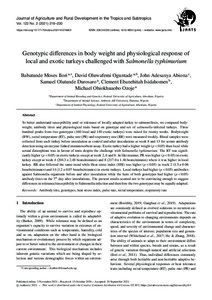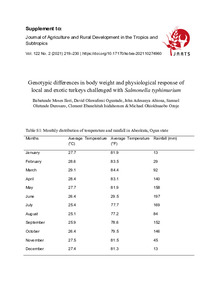| dc.date.accessioned | 2021-11-02T17:55:22Z | |
| dc.date.available | 2021-11-02T17:55:22Z | |
| dc.date.issued | 2021-11-02 | |
| dc.identifier | doi:10.17170/kobra-202110274960 | |
| dc.identifier.uri | http://hdl.handle.net/123456789/13352 | |
| dc.language.iso | eng | eng |
| dc.rights | Namensnennung 4.0 International | * |
| dc.rights.uri | http://creativecommons.org/licenses/by/4.0/ | * |
| dc.subject | antibody titre | eng |
| dc.subject | genotypes | eng |
| dc.subject | heat stress index | eng |
| dc.subject | pulse rate | eng |
| dc.subject | rectal temperature | eng |
| dc.subject | respiratory rate | eng |
| dc.subject.ddc | 590 | |
| dc.subject.ddc | 630 | |
| dc.title | Genotypic differences in body weight and physiological response of local and exotic turkeys challenged with Salmonella typhimurium | eng |
| dc.type | Aufsatz | |
| dcterms.abstract | To better understand susceptibility and/ or tolerance of locally adapted turkey to salmonellosis, we compared bodyweight, antibody titres and physiological traits based on genotype and sex of salmonella-infected turkeys. Three hundred poults from two genotypes (160 local and 140 exotic turkeys) were raised for twenty weeks. Bodyweight (BW), rectal temperature (RT), pulse rate (PR) and respiratory rate (RR) were measured weekly. Blood samples were collected from each turkey before and after inoculations at week 8 and 13 for serum antibody detection using enzyme-linked immunosorbent assay. Genotype had a significant (p < 0.05) effect on all the parameters measured. Exotic turkey had higher weight than local while sexual dimorphism was in favour of toms despite challenge with Salmonella typhimurium. The RT was significantly higher (p < 0.05) in exotic turkeys except at week 2, 6 and 8. In like manner, PR was higher (p < 0.05) in exotic turkey except at week 4 (204.28±2.48 beats/minutes) and 8 (216.98±1.46 beats/minutes) where it was higher in local turkey. RR also followed the same trend while HSI was higher (p < 0.05) in week 2 (1.53±0.06 breaths/minutes) and 14 (1.17±0.07 breaths/minutes) in exotic turkeys. Local turkeys had higher (p < 0.05) antibodies against Salmonella organisms before and after inoculation while the hens of both genotypes had higher (p < 0.05) antibody titres at the 7th day after inoculations. The present results seemed not to be convincing enough to suggest differences in tolerance/susceptibility to Salmonella infection and therefore the two genotypes may be equally adapted. | eng |
| dcterms.accessRights | open access | |
| dcterms.creator | Ilori, Babatunde Moses | |
| dcterms.creator | Oguntade, David Oluwafemi | |
| dcterms.creator | Abiona, John Adesanya | |
| dcterms.creator | Durosaro, Samuel Olutunde | |
| dcterms.creator | Isidahomen, Clement Ebanehitah | |
| dcterms.creator | Ozoje, Michael Ohiokhuaobo | |
| dc.subject.swd | Truthuhn | ger |
| dc.subject.swd | Salmonella typhimurium | ger |
| dc.subject.swd | Antikörper | ger |
| dc.subject.swd | Wärme | ger |
| dc.subject.swd | Pulsfrequenz | ger |
| dc.subject.swd | Körpertemperatur | ger |
| dc.subject.swd | Atemfrequenz | ger |
| dc.subject.swd | Genotyp | ger |
| dc.type.version | publishedVersion | |
| dcterms.source.identifier | eissn:2363-6033 | |
| dcterms.source.issue | No. 2 | |
| dcterms.source.journal | Journal of Agriculture and Rural Development in the Tropics and Subtropics (JARTS) | eng |
| dcterms.source.pageinfo | 219-230 | |
| dcterms.source.volume | Vol. 122 | |
| kup.iskup | false | |



